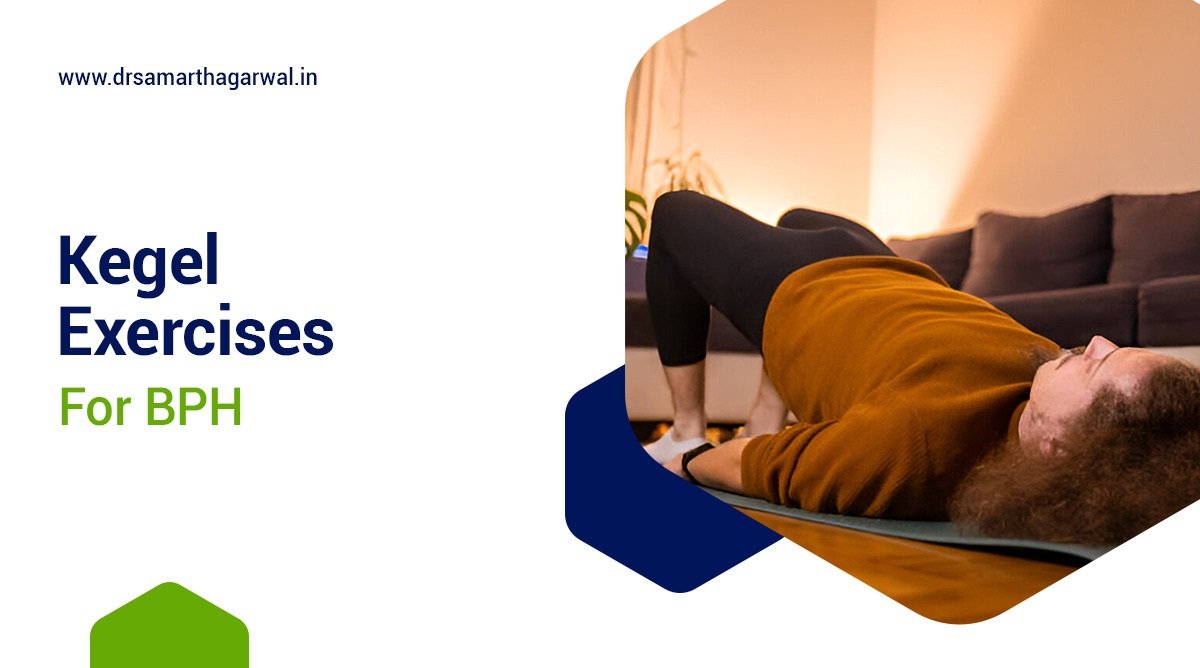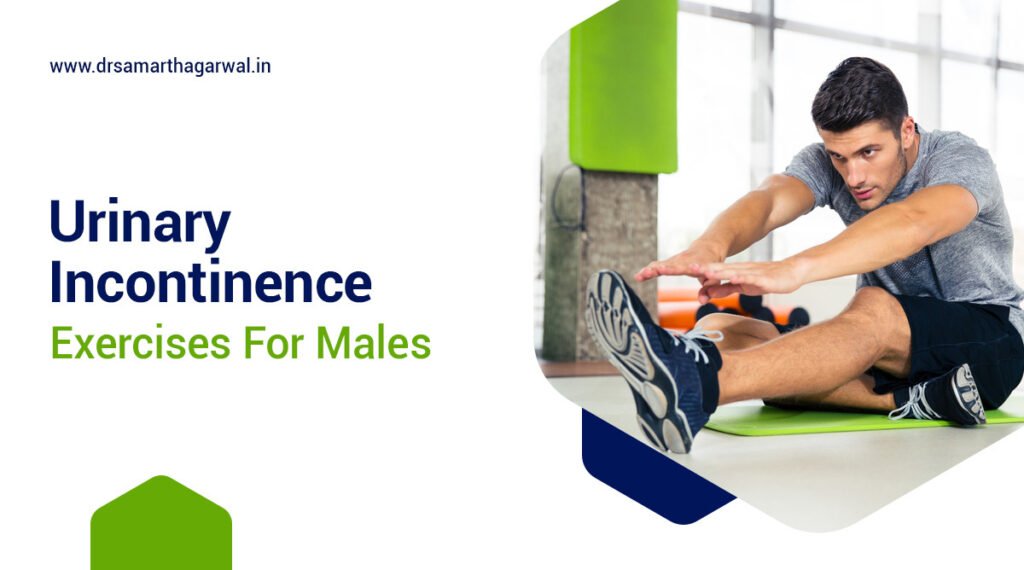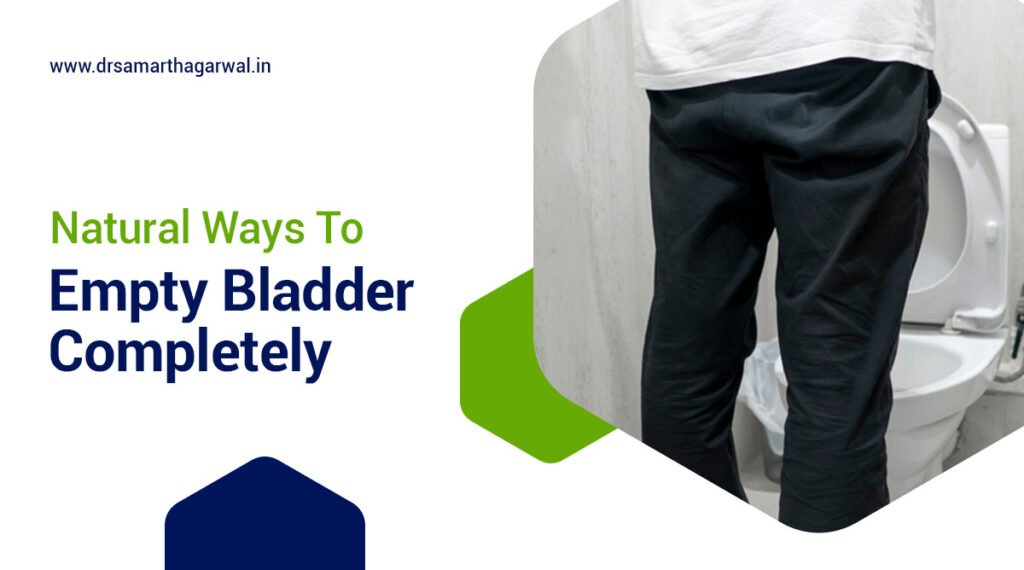Benign Prostatic Hyperplasia (BPH) is a common condition affecting many men as they age, often leading to uncomfortable urinary symptoms, including frequent urges and overactive bladder.
Kegel exercises, a key component of male pelvic floor training, offer a simple yet effective way to manage these symptoms and improve urinary incontinence.
This article explores what BPH is, how Kegel exercises can benefit those affected, and provides practical guidance on different types of exercises tailored for improving pelvic floor strength while enhancing bladder control.
Discover how to enhance bladder control and overall well-being with these easy-to-follow techniques, making them a permanent part of your daily routine.
According to Hagovska, M.’s 2024 study, ‘The effect of pelvic floor muscle training in men with benign prostatic hyperplasia and overactive bladder’, effects of combining pelvic floor muscle training with silodosin in men with benign prostatic hyperplasia (BPH) and overactive bladder (OAB) over 12 weeks. A total of 158 men were divided into two groups: one received silodosin alone, while the other received both silodosin and pelvic floor training. Results showed that the group receiving both treatments had significantly better outcomes, including fewer daily voids, reduced urgency, and improved symptom scores. The findings suggest that adding pelvic floor training to silodosin is an effective first-line treatment for OAB in men with BPH.
What Is BPH?
Benign Prostatic Hyperplasia (BPH) is a common condition affecting males, particularly those over the age of 50, characterized by the enlargement of the prostate gland. This enlargement can lead to various urinary symptoms such as frequent urges, urine leakage, and difficulty in bladder control, often impacting the quality of life. BPH is not cancerous but can affect urinary function significantly, causing discomfort and distress among patients. Understanding BPH is essential for recognizing its potential complications, including its association with prostate cancer and surgical interventions like prostatectomy. Benign Prostatic Hyperplasia (BPH) is a common condition affecting males, particularly those over the age of 50, characterized by the enlargement of the prostate gland. This enlargement can lead to various urinary symptoms such as frequent urges, urine leakage, and difficulty in bladder control, often impacting the quality of life. BPH is not cancerous but can affect urinary function significantly, causing discomfort and distress among patients. Understanding BPH is essential for recognizing its potential complications, including its association with prostate cancer and surgical interventions like prostatectomy.
What Are Kegel Exercises?
Kegel exercises, or pelvic floor exercises, strengthen the pelvic floor muscles by focusing on their contraction and relaxation. They support the bladder, bowel, and uterus in females, and the bladder in males. Regular practice can improve bladder control, reduce urinary incontinence, and enhance pelvic health. For men, Kegels may also boost sexual performance and help with issues related to benign prostatic hyperplasia (BPH).
How Do Kegel Exercises Help with BPH?
Kegel exercises are a valuable tool for individuals dealing with Benign Prostatic Hyperplasia (BPH), a condition that can lead to uncomfortable urinary symptoms. By focusing on strengthening the pelvic floor muscles, these exercises can significantly improve bladder control and overall quality of life for those affected. Here are some key ways Kegel exercises help manage BPH symptoms:
How Kegel Exercises Help with BPH:
- Enhance Bladder Control: Strengthen pelvic floor muscles to improve bladder function.
- Reduce Urine Leakage: Help manage incontinence and minimize leakage.
- Manage Urinary Symptoms: Alleviate frequent urges to urinate.
- Promote Pelvic Floor Activity: Improve overall pelvic floor health and function.
- Improve Quality of Life: Enhance daily living by reducing BPH-related discomfort.
- Provide Sense of Control: Increase confidence in managing bladder function during routine tasks.
What Are the Different Types of Kegel Exercises for BPH?
There are several types of Kegel exercises targeting the pelvic floor muscles, each designed to improve urinary health and pelvic strength for those with BPH. These include Basic Kegel exercises, Reverse Kegel exercises, Squeeze and Release exercises, and Pelvic Floor Muscle Training. Each variation strengthens essential pelvic muscles, helping alleviate urinary symptoms associated with BPH. Understanding these types empowers individuals to effectively incorporate them into their routines for consistent exercise.Understanding these different types can give the power to individuals to incorporate them into their routine effectively.
Basic Kegel Exercises
Basic Kegel exercises involve the simple practice of contracting and relaxing the pelvic floor muscles, a fundamental technique for strengthening these essential muscles. To perform this exercise, individuals should identify the correct muscles by stopping urination midstream, contracting them for a few seconds, and then relaxing. Basic Kegel exercises involve the simple practice of contracting and relaxing the pelvic floor muscles, a fundamental technique for strengthening these essential muscles. To perform this exercise, individuals should identify the correct muscles by stopping urination midstream, contracting them for a few seconds, and then relaxing.
Incorporating these exercises into a regular routine can significantly enhance urinary health and provide numerous benefits over time, improving urine flow and managing symptoms of BPH.
- First, it’s crucial to ensure that the right muscles are engaged. A helpful tip is to visualize the muscles lifting internally as you contract.
- Seconds of holding contraction should gradually increase, aiming for a duration of up to ten seconds, followed by the same relaxation period.
- This practice can be easily done while sitting, standing, or even lying down, making it an adaptable part of one’s daily activities.
Consistent engagement of the pelvic floor muscles can lead to improved bladder control, reduction in incontinence issues, and greater comfort during physical activities.
Over time, those who embrace this exercise routine often notice a more resilient pelvic floor, positively influencing their overall quality of life and reducing common side effects related to BPH.
Reverse Kegel Exercises
Reverse Kegel exercises focus on relaxing the pelvic floor muscles rather than contracting them, which can help improve overall pelvic flexibility. This technique involves taking a deep breath while gently pushing the pelvic floor muscles downward, creating a sensation of ‘bearing down.’ By incorporating Reverse Kegel exercises into a regular routine, individuals can enhance their pelvic floor training and contribute to better bladder control.
Learning how to perform these exercises correctly is crucial. Start by finding a comfortable position, such as sitting or lying down. As you breathe in deeply, consciously relax your pelvic muscles, allowing them to lengthen and release tension. It’s essential to maintain a natural breathing pattern throughout, ensuring that the rest of your body remains relaxed. Consultation with a health care provider can provide additional guidance.
- Combining Reverse Kegels with traditional Kegels can provide a well-rounded approach to strengthening and relaxing the pelvic floor.
- These exercises may help alleviate issues such as pelvic pain or urinary incontinence.
- Incorporating them into daily routines can improve sexual function and enhance overall core stability.
By focusing on both contraction and relaxation, individuals can promote healthier pelvic floor muscles and achieve better results in their exercises.
Squeeze and Release Exercises
Squeeze and Release exercises are a variation of Kegel exercises that involve holding the contraction of the pelvic floor muscles for a prolonged period followed by a complete release. This technique promotes muscle endurance and strength, which are essential for effectively managing urinary symptoms associated with BPH. Regularly doing these exercises enhances exercise consistency. To perform this exercise, individuals can hold the contraction for a few seconds, then release and rest for a moment before repeating. Consistency in this exercise routine can lead to significant improvements in bladder control.
To get started, one should find a comfortable position, such as lying down or sitting upright. It’s crucial to engage the pelvic floor muscles properly, maintaining focus on proper technique.
- Start by tightening these muscles for about 3 to 10 seconds, depending on comfort.
- After this contraction, rest for an equal duration to allow the muscles to recover.
- Repeat this cycle 10 to 15 times per session.
It’s particularly important to listen to the body; strain can be counterproductive. As these exercises become easier, gradually increasing the contraction duration can enhance muscle endurance.
Regular practice plays a vital role in improving overall urinary health, making these exercises essential for those seeking better bladder control and reducing urine leakage.
Pelvic Floor Muscle Training
Pelvic floor muscle training encompasses a variety of exercises, including Kegel exercises, that aim to strengthen and improve coordination of the pelvic floor muscles. Techniques such as feedback training and biofeedback sessions can be beneficial for individuals learning how to effectively engage these muscles.
Incorporating elements like real-time monitoring can significantly enhance the overall training.
Biofeedback methods provide an interactive platform where individuals can visualize their muscle contractions, making it easier to understand how to apply force correctly. As participants engage in this training, they can focus on their pelvic floor activity, which has shown to be particularly useful for managing the symptoms of Benign Prostatic Hyperplasia (BPH) and other prostate problems.
- This feedback allows for adjustments in technique, ensuring that the exercises yield the maximum benefit.
- Such a method can encourage consistent practice, leading to improved muscle memory and coordination.
Ultimately, combining these innovative techniques with traditional exercises can lead to notable improvements in bladder control and overall pelvic health.
How to Do Kegel Exercises Properly?
Performing Kegel exercises properly is crucial for achieving the desired benefits such as improved bladder control and reduced urinary symptoms associated with BPH. The first step is to identify the correct pelvic floor muscles by attempting to stop urination midstream. Once identified, individuals should focus on contracting these muscles while breathing freely and maintaining proper form throughout the exercises. Understanding the proper technique ensures effective muscle engagement and maximizes results over time, potentially reducing the need for surgical removal or prostatectomy.
There is a significant concern regarding the effectiveness of Kegel exercises among women. According to Huang, Y.-C., & Chang, K.-V. (2023), approximately 30% struggle to correctly contract their pelvic floor muscles, highlighting a gap in proper training and understanding. Furthermore, a staggering 46.1% of patients have not received adequate information about these exercises, which are crucial for pelvic health. Research indicates that supervised Kegel exercises yield better outcomes, including improved quality of life and reduced urine leakage, yet many women may not have access to such guidance.
Additionally, brief verbal instructions often prove insufficient for beginners, underscoring the need for comprehensive education on the topic. To achieve meaningful results, it is essential that training programs last for more than three months, with a minimum of eight weeks recommended to effectively strengthen pelvic muscles. This lack of awareness and proper instruction raises concerns about the overall effectiveness of Kegel exercises and the potential impact on women’s health.
Find the Right Muscles
Finding the right muscles is the first essential step to effectively performing Kegel exercises and involves learning to identify the pelvic floor muscles responsible for controlling urination. A simple method to locate these muscles is to stop urination midstream; the muscles used to do this are the ones you will want to train. Once identified, practice contracting and relaxing these muscles to build control and strength, which is vital for managing urinary symptoms related to BPH. Finding the right muscles is the first essential step to effectively performing Kegel exercises and involves learning to identify the pelvic floor muscles responsible for controlling urination. A simple method to locate these muscles is to stop urination midstream; the muscles used to do this are the ones you will want to train. Once identified, practice contracting and relaxing these muscles to build control and strength, which is vital for managing urinary symptoms related to BPH.
To further enhance the identification process of the pelvic floor muscles, beginners may consider using various techniques such as feedback training or a biofeedback session. Consulting a health care provider for additional health tips can also be beneficial.
- Visualization: Picture the pelvic floor as a hammock that supports the organs above. This mental image aids in focusing on the right area and helps identify muscles for effective Kegel exercises.
- Body Awareness: Pay attention to sensations in the pelvic area during everyday activities, like sneezing or lifting. This can help pinpoint muscle engagement and maintain focus on correctly contracting pelvic floor muscles.
- Mirror Feedback: In privacy, using a handheld mirror can enable individuals to observe muscle contraction visually, ensuring proper contract and relax techniques.
These methods not only aid in identifying the pelvic floor muscles but also enhance the effectiveness of Kegel exercises. Regular practice will lead to improved muscle coordination and strength over time, essential for maintaining pelvic health.
Start Slowly
Starting slowly is crucial when beginning Kegel exercises to ensure that the pelvic floor muscles are not overstrained and to develop proper technique. Taking the time to understand each movement lays the foundation for effective results.
Begin with short contractions, holding for around three to five seconds, and rest for an equal period before repeating. It’s essential to focus on breathing freely during the exercises, which helps maintain relaxation and prevents tension in other areas of the body.
To integrate these exercises into a daily routine, enhancing mens health, consider the following:
- Set reminders on your phone to perform the exercises at specific times, such as during morning routines or while watching TV.
- Pair Kegels with other daily activities, like sitting at a desk or standing in line.
- Keep a log to track consistency and observe your progress, which will motivate you to stay committed.
Gradually, as strength builds, individuals can increase the duration of their contractions. This steady approach not only fosters development but also ensures that the body adapts comfortably to the changes.
Maintain Proper Form
Maintaining proper form during Kegel exercises is vital for maximizing benefits and ensuring safety. Individuals should remain relaxed and avoid tensing the abdominal, buttock, or thigh muscles while focusing solely on contracting the pelvic floor muscles. Remember to breathe freely, allowing oxygen flow while performing the exercise. This focus on proper technique will not only enhance pelvic floor activity but also prevent common side effects such as discomfort or strain.
To cultivate better results, practitioners might consider setting aside a quiet space to perform their Kegel exercises, free from distractions. Establishing a routine is key; try allocating a few minutes daily to focus on pelvic floor activation. Utilizing mental imagery can also help—envision drawing the muscles upward and inward, enhancing concentration.
- Prioritize relaxation by taking a few deep breaths before starting.
- Focus on engaging only the pelvic floor muscles; if other areas tighten, take a step back and reset.
- Avoid holding your breath; maintain a steady, rhythmic pattern during contractions.
Improper technique can indeed lead to adverse effects such as increased pelvic pressure or muscle fatigue. Thus, reinforcing correct practices is essential for achieving desired outcomes while safeguarding overall pelvic health.
Increase Intensity and Duration
As strength and proficiency in Kegel exercises increase, it’s essential to gradually increase the intensity and duration of the workouts to continue seeing improvements. This can be achieved by extending the contraction hold time and adding more repetitions to the exercise routine. By focusing on pelvic floor training with increased intensity, individuals can effectively enhance bladder control and reduce urinary incontinence associated with BPH.
Tracking progress through a journal or an app can make a significant difference. Setting small, achievable goals over time, such as increasing the number of repetitions or extending each hold by just a few seconds, encourages ongoing engagement.
To maintain motivation, one might consider the following strategies:
- Creating a regular schedule for workouts to establish a routine.
- Rewarding oneself for milestones reached.
- Joining online communities or support groups.
Staying committed to pelvic floor strengthening exercises not only leads to better results but also fosters a sense of accomplishment as one witnesses the positive changes in their overall health.
What Are the Benefits of Kegel Exercises for BPH?
Kegel exercises offer numerous benefits for individuals suffering from Benign Prostatic Hyperplasia (BPH), significantly improving bladder control and reducing urinary symptoms. These exercises strengthen the pelvic floor muscles, which play a crucial role in maintaining urinary function and can lead to improved urine flow. Regular practice of Kegel exercises not only enhances overall pelvic health but also positively impacts the quality of life by alleviating discomfort and the urgency associated with urinary symptoms of BPH.
Improves Bladder Control
One of the primary benefits of Kegel exercises is their ability to significantly improve bladder control by strengthening the pelvic floor muscles that support the bladder. Enhanced muscle strength helps reduce urinary incontinence and provides better control over urinary urges, ultimately leading to a more confident and comfortable lifestyle. Regularly practicing these exercises can contribute to greater muscle endurance and control, reinforcing the effectiveness of pelvic floor training.
Kegel exercises are particularly beneficial for women, especially during and after pregnancy, as well as for older adults experiencing age-related decline in muscle strength. Studies show that approximately 50% of women and up to 25% of men experience some form of urinary incontinence in their lifetime.
Consistent practice can lead to a remarkable improvement, with research indicating a success rate of about 70% in those who engage in these exercises regularly for a few months.
- Improvement in bladder control increases confidence.
- Training can also help alleviate stress-related incontinence.
- Commitment is essential; practicing Kegel exercises at least three times a week is recommended.
By incorporating such simple yet effective routines, supported by consultation with doctor, into daily life, individuals may notice a significant reduction in leakage episodes, enhancing their overall quality of life.
Strengthens Pelvic Floor Muscles
Kegel exercises are highly effective for strengthening the pelvic floor muscles, which are essential for numerous bodily functions, including bladder control and sexual health. By engaging in a consistent exercise routine targeting these muscles, individuals can see significant improvements in muscle strength and coordination, particularly for men dealing with BPH. A stronger pelvic floor can lead to improved urinary function and enhanced sexual performance, contributing to a better quality of life.
For many men, understanding the role of these muscles is crucial for overall well-being. In fact, the benefits of pelvic floor muscle strength transcend beyond just physical aspects; they also include enhanced confidence and emotional health. Regularly practicing Kegel exercises can help alleviate symptoms related to benign prostatic hyperplasia (BPH), ensuring that issues like frequent urination and weak stream become manageable.
- Consistency in exercise is key to reaping the full benefits.
- Incorporating different variations can target various areas of the pelvic floor.
- Tracking progress can encourage ongoing commitment.
Ultimately, focusing on these exercises can lead to transformative changes, making them an essential part of any health-conscious routine.
Reduces Urinary Symptoms of BPH
Kegel exercises have been shown to effectively reduce urinary symptoms associated with Benign Prostatic Hyperplasia (BPH), including urine leakage and frequent urges. By consistently practicing these exercises, individuals can strengthen their pelvic floor muscles, leading to better support of the bladder and improved control over urinary functions. This reduction in urinary symptoms can significantly enhance one’s quality of life, providing relief from the discomfort often experienced with BPH.
Studies reveal that incorporating Kegel exercises into one’s daily routine can result in noticeable improvements in urinary control within a few weeks. According to a survey conducted by the Urology Care Foundation, approximately 70% of participants reported fewer urges and instances of leakage after consistent practice.
- Reduced Urgency: Less frequent and intense urges to urinate.
- Improved Control: Enhanced ability to delay urination.
- Increased Confidence: Reduced anxiety about potential leaks while out or during social activities, enhancing quality of life in Delhi and beyond.
This evidence not only underscores the importance of pelvic floor exercises but also serves as a motivating factor for those dealing with the challenges of BPH. These exercises are vital for managing benign prostatic hyperplasia (BPH) and potentially preventing prostate cancer complications.
Increases Sexual Function
Plus improving bladder control, Kegel exercises can also significantly enhance sexual function in men. Strengthening the pelvic floor muscles contributes to better blood flow and overall muscle tone, which can improve sexual performance and satisfaction. By incorporating Kegel exercises into their routine, men dealing with BPH may find not only relief from urinary symptoms but also an increase in their sexual health and confidence.
Research indicates that men who engage in regular pelvic floor training, including Kegel exercises, can experience a range of benefits, including improved erectile function and heightened sexual pleasure. A study published in the Journal of Urology revealed that over 70% of participants noticed a marked improvement in their erectile capabilities after a 12-week Kegel program. Additionally, Elsevier and clinical key have published research supporting these findings.
- Enhanced blood circulation, leading to firmer erections.
- Increased stamina during sexual activity.
- Improved control over ejaculation, fostering intimacy.
These findings underscore the importance of sexual health practices, highlighting Kegel exercises as a valuable tool for men looking to enhance their sexual performance and overall satisfaction.
Are There Any Risks or Side Effects of Kegel Exercises?
While Kegel exercises are generally safe and beneficial for most individuals, including those practicing Diy Kegel exercises, there are potential risks and side effects that practitioners should be aware of. Over-exertion or improper technique during Kegel exercises can lead to muscle strain, pelvic pain, or discomfort. Additionally, some individuals may not effectively identify the right muscles, leading to ineffective practice and potential exacerbation of urinary symptoms of BPH (benign prostatic hyperplasia). It’s essential to maintain proper form and consult a healthcare provider if any unusual discomfort arises during exercises.
How Often Should Kegel Exercises Be Done?
To achieve optimal results from Kegel exercises, it’s essential to establish a consistent exercise routine and determine the appropriate frequency for practice. Experts generally recommend performing Kegel exercises at least three times per week, with multiple sets of contractions each day to help improve urine flow and reduce urinary symptoms. By regularly incorporating these exercises into daily life, individuals can strengthen their pelvic floor muscles and experience significant benefits over time.
Additional Tips for Performing Kegel Exercises for BPH and Prostate Health
Plus understanding how to perform Kegel exercises, incorporating essential health tips and guidance can significantly enhance the effectiveness of pelvic floor training for individuals dealing with BPH. Utilizing feedback training methods, such as using biofeedback devices, can help track progress and ensure proper muscle engagement. Furthermore, setting realistic goals and maintaining consistency in the exercise routine are crucial elements for achieving long-term benefits and improving overall health. It’s also worth noting that combining these exercises with regular physical activity can amplify the benefits.

For inquiries or concerns regarding your urinary health related to Kegel exercises for BPH, please reach out to Dr. Samarth Agarwal!







